Orbicular granite
Orbicular granite (also known as orbicular rock or orbiculite) is an uncommon plutonic rock type which is usually granitic in composition. These rocks have a unique appearance due to orbicules - concentrically layered, spheroidal structures, probably formed through nucleation around a grain in a cooling magma chamber due to rapid physical changes.[1] Almost one third of known orbicular rock occurrences are from Finland.[2] The occurrences are usually very small.[3]
| Igneous rock | |
 Polished rock sample of orbicular granite from Mount Magnet, Western Australia. | |
| Composition | |
|---|---|
| Granitic |


Occurrences
Chile
- On the coastline eleven kilometres north of Caldera, Northern Chile, there is a body of Jurassic orbicular granite which is dyke-like with an exposed surface area of approximately 375 m2, enclosed in a tonalitic batholith. Where visible, the contact between country rock and the orbicular body is characterized by a zone of comb layering. The orbicular body has a porphyritic granodiorite matrix. The surface ratio of matrix/orbicules is 35/65; orbicules are mainly ellipsoidal with an average axis of 7.0 cm and are composed of a quartz diorite core and a single dark shell with a predominantly radial texture composed of equal amounts of plagioclase and amphibole accompanied by lesser amounts of clinopyroxene, biotite and magnetite. The core of the orbicules is polycrystalline and corresponds to a medium gray, medium grained (1.5 to 2.0 mm) quartz diorite composed of plagioclase, amphibole, quartz, biotite, small amounts of K-feldspar, clinopyroxene, and accessories, mainly magnetite. The texture is hypidiomorphic granular. There is a close petrographic similarity between the core of the orbicules, the non-orbicular inclusions and country rock.[4] The site has been declared a protected area ("Santuario de la Naturaleza").
- An orbicular granodiorite exists at Cordón de Lila south of Salar de Atacama. The orbicular granodiorite occur in the form of a pipe that is part of the more extensive pluton of El León. Magmas forming these rocks cooled into rock in the Ordovician.[5]
- A rare type of orbicular rock (locally known as Chaitenita) was discovered in Cerro Recoba, Chaitén, in 2017. The orbicular body consists of an irregular dyke of 75 m2 and is hosted by a granodiorite of Miocene age. The orbs are characterized by a single shell of 1 to 10 mm composed of radial plagioclase, quartz, and k-feldspar surrounding different kinds of igneous and, possibly, metamorphic cores.[6]
South Africa
In the Namaqualand, South Africa, just west of the small town of Concordia, there is a rare occurrence of orbicular granite. The outcrop, known as Orbicule Hill or "wonderkoppie" (as it is locally known), is a provincial heritage site and one of just two known occurrences in South Africa. When cut and polished, the granite has a very attractive pinkish colour with lighter and darker shades of grey oval shaped or orbicular inclusions. Orbiculite has been used to make jewellery and other decorative items in the past, but due to its rarity in South Africa, it is not commercially exploited and has become more a curiosity due to it being considered something of an enigma in geology. The geology of the surrounding area can be described as gneissic and granitic and is better known for its once rich copper deposits. The rocks of this region form part of the mid Proterozoic Eon and formed approximately one billion years ago.[7][8]
Other localities
- Powell River Area, British Columbia, Canada
- Cape Geology in Granite Harbour, McMurdo Sound, Antarctica[9]
- Concordia, South Africa
- Karamea, New Zealand[10]
- Split Apple Rock, Kaiteriteri, New Zealand[11]
- Kuru, Finland
- Matobo National Park, Zimbabwe
- Mount Magnet, Western Australia
- Savitaipale, Finland
- Slättemossa, south of Järnforsen, Hultsfred, Sweden[12][13][1]
- Taylor Valley in Antarctica
- Mullaghderg, County Donegal, Ireland[14]
- Peneda-Gerês National Park, Portugal[15]
- Sandia Mountains, New Mexico, USA[16]
- Pichor, Bundelkhand Massif, India[17]
References
- Lindh, Anders; Näsström, Helena (September 2006). "Crystallization of orbicular rocks exemplified by the Slättemossa occurrence, southeastern Sweden". Geological Magazine. 143 (5): 713–722. doi:10.1017/S001675680600210X. ISSN 1469-5081.
- Mineralogical Magazine; April 2006; v. 70; no. 2; p. 238-239: Book Review
- Kristallin.de: Orbicular rocks vs. Rapakivis
- An orbicular tonalite from Caldera, Chile. Aguirre, L., Hervé, F. and Del Campo, M. (1976). Journal of the Faculty of Science, Hokkaido University, Japan. Vol. 17 (2), pp. 231-259
- Niemeyer Rubilar, Hans (2018). "La granodiorita orbicular del Cordón de Lila, región de Antofagasta, Chile". Andean Geology (in Spanish). 45 (1). doi:10.5027/andgeoV45n1-3114. Retrieved January 8, 2018.
- Soto, Aníbal (2019). "La granodiorita orbicular del Cerro Recoba, Batolito Patagónico Norte, Chaitén |". University of Chile (in Spanish).
- Norman, Nick; Whitfield, Gavin (2006). Geological Journeys: A Traveller's Guide to South Africa's Rocks and Landforms. Struik. ISBN 978-1770070622.
- Smalberger, John M. (1975). Aspects of the history of copper mining in Namaqualand, 1846-1931. Struik. ISBN 978-0869770436.
- "British Antarctic "Terra Nova" 1910-1913 Expedition Reports". 1914. Retrieved 29 March 2017.
- Te Ara Encyclopedia of New Zealand
- "Sites and Sections". Nelson Rock and Mineral Club. Retrieved 2019-06-30.
- Hultsfred municipality
- "Orbiculit von Slättemossa in Schweden". www.kristallin.de. Retrieved 2019-10-16.
- "Areas of Geological Interest in County Donegal" (PDF). Donegal County Council. Retrieved 29 March 2017.
- Simões, Margarida C.; "Ocorrência de granito orbicular em Couto do Osso, Serra da Peneda", in: Margarida C. Simões, Armando Moreira: Volume de homenagem ao Professor Doutor Carlos Teixeira / [ed. lit.] Sociedade Geológica de Portugal ; introdução Décio Thadeu & Fernando Real. - Lisboa : Sociedade Geológica de Portugal, 1981. - p. 125-128. Cota:7-294 NBP 30944
- Enz, Robert D., Albert M. Kudo, and Douglas G. Brookins; Igneous origin of the orbicular rocks of the Sandia Mountains, New Mexico, Geological Society of America Bulletin, February, 1979, v. 90, p. 138-140
- Basu, Adhir Kumar (2007). "Role of the Bundelkhand Granite Massif and the Son-Narmada megafault in precambrian crustal evolution and tectonism in Central and Western India". Journal of the Geological Society of India. 70: 745–770.
| Wikimedia Commons has media related to Orbicular rock. |